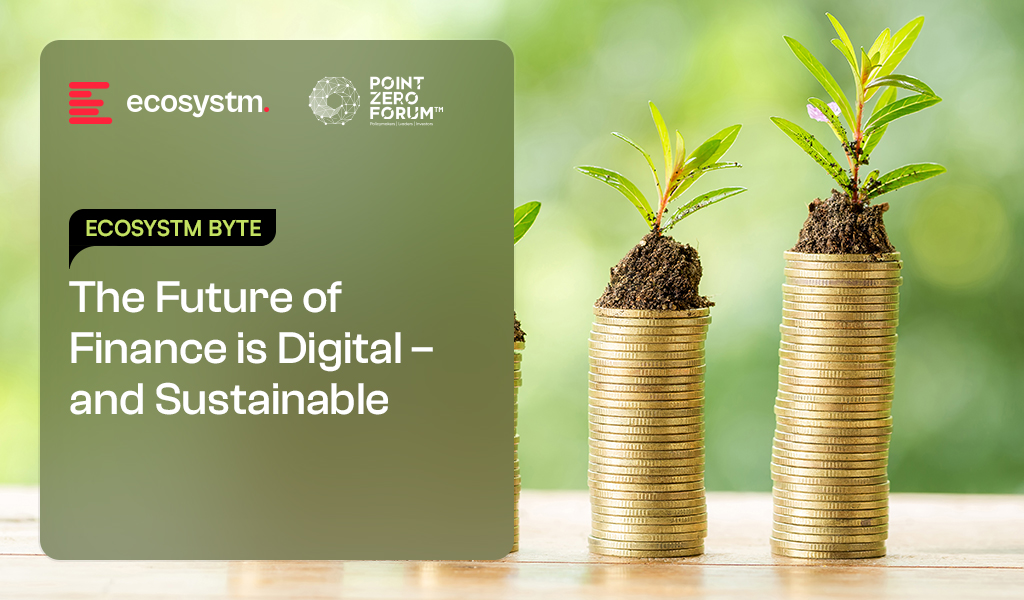GreenTech is reshaping finance by fusing technology with sustainability. From startups to large financial institutions, there’s a clear push to embed climate intelligence into financial decisions. In 2024, green fintech investments hit USD 2.7B – underscoring strong momentum and growing confidence in tech-led sustainability solutions.
The focus is sharp: drive financial innovation while delivering real environmental impact.
Here’s a look at key Green Finance trends that are reshaping the industry.
Click here to download “The Future of Finance is Digital – and Sustainable” as a PDF.
Catalysing Change: Impact Investing
Impact investing is going mainstream, especially in fast-growing emerging markets.
This shift reflects a growing realisation: private capital is critical to climate action, and tackling climate risks is a financial opportunity, not just an ethical choice.
AVPN (Asian Venture Philanthropy Network) has launched ImpactCollab – a platform linking finance professionals with verified impact organisations, due diligence tools, and monitoring resources. Initially used by private banks in Singapore to bolster philanthropy advisory, it will soon expand into blended finance and impact investing, backed by MAS.
Green bonds are also gaining momentum, driven by investor demand, regulatory tailwinds, and rising climate risk awareness. In Singapore, NUS, UOB, and Northern Trust piloted tokenised green bond reporting to boost transparency. India, meanwhile, opened its sovereign green bonds to foreign investors via the Fully Accessible Route (FAR), unlocking global capital for climate goals.
Empowering Customers with Carbon Insights
Carbon tracking is becoming a staple in digital banking, driven by a growing demand for transparency around environmental impact. Banks are responding by embedding carbon calculators into apps – enabling users to measure emissions, benchmark against national averages, and get actionable tips to reduce their footprint.
In Indonesia, Bank Mandiri has launched an in-app feature that helps customers track their personal carbon emissions, making it easy to understand the environmental impact of daily actions. The Royal Bank of Canada has partnered with a carbon management platform to offer businesses tools to monitor and manage their emissions.
These moves reflect a broader shift: banks are embedding sustainability into everyday financial behaviour and deepening customer engagement through purpose-driven services.

Blockchain-Enabled Carbon Trading
Blockchain is transforming carbon trading by enabling a decentralised, transparent, and secure way to verify and transact carbon credits.
This technology addresses long-standing issues of fraud and inefficiency, offering a more reliable and cost-effective approach to managing credits and meeting climate goals.
Thailand has eased crypto regulations to promote blockchain-based carbon trading, positioning itself as a leader in sustainable tech. Meanwhile, US-based financial services firm Northern Trust has launched a blockchain platform that allows project developers to generate, verify, and trade voluntary carbon credits in near real-time. Together, these moves signal a shift toward mainstream adoption of blockchain in carbon markets.
Addressing the Climate Risk Gap
As climate risks intensify, small and medium enterprises (SMEs) are seeking tools to assess and manage their exposure. Despite being highly vulnerable to climate events, SMEs often lack the resources to navigate complex risk landscapes.
Fintechs are stepping in with climate risk-scoring tools that help SMEs identify vulnerabilities and take proactive steps – such as securing insurance or adapting their strategies.
Marsh has highlighted the need for SME-focused climate assessments in New Zealand, particularly for high-risk sectors. Its Climate Risk Navigator helps businesses build resilience and make informed decisions on insurance and sustainability. In India, insurers like ICICI Lombard are using geospatial tech – GIS, satellite imagery, and AI – to power climate-linked products. For example, its satellite-based insurance for wheat farmers in Punjab enables faster, more accurate yield assessments and claim settlements.
Rise of Climate-Conscious Crypto
Once criticised for high energy use, crypto mining is undergoing a green makeover – fuelled by surplus renewable energy and optimised by AI.
What was seen as wasteful is now being reimagined as a tool for grid stability and sustainable growth.
In Switzerland’s Canton of Bern, Bitcoin mining is being explored as a way to absorb excess power and stabilise the grid. In the UK, mining firms are tapping into unused wind energy during off-peak hours to avoid waste. This shift is reaching emerging markets too – Pakistan is converting surplus electricity into value by launching state-backed Bitcoin mining and AI data centres, turning untapped power into economic opportunity.
Ecosystm Opinion
Becoming truly sustainable presents a unique challenge for financial organisations, as their responsibility extends beyond internal operational efficiencies to actively empowering customers and the wider ecosystem to embrace green practices. This is compounded by a growing reliance on increasingly compute-intensive and energy-inefficient technologies.
The recent and growing emphasis on Green Finance offers a promising outlook, suggesting a positive shift in the industry’s trajectory towards a more sustainable future.

The 2021 United Nations Climate Change Conference (COP26, that was held in Glasgow in 2021, highlighted the need to mobilise public and private sector finance to support global net-zero emissions targets and to protect communities and habitats.
Sustainable Finance and Green Bonds present opportunities for lenders, investors, and borrowers. It allows borrowers to obtain funding at decreased and competitive costs. And as investor demands continue to rise, Government institutions have expressed keen interest in issuing green bonds to support ecologically beneficial initiatives.
Here are some recent global announcements.
- France announces the issuance of USD 4 billion green bond sale.
- Germany raises USD 4 billion in green bonds to finance green expenditures and investments.
- Singapore sets a roadmap for its first sovereign green bond with the Singapore Green Bond Framework.
- Austria launches its first green bond.
- The UK launches an inquiry into the role of the financial sector in the country’s net zero transition.
Download Building a Climate Resilient Future with Sustainable Finance as a PDF






















